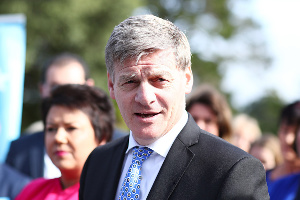
Many economists believe the country will have bounced out of recession after two consecutive contractions, in the fourth quarter of last year and first quarter of this year, which meant a technical recession.
HSBC chief economist for Australia and New Zealand Paul Bloxham, says recent activity indicators suggest the country is in a recession.
Speaking at a recent Auckland FINSIA breakfast, he says inflation has been extraordinarily high relative to recent history and the targets central banks set. “We have had this really large lift in inflation and that's been front and centre for policymakers.”
He says the economy has become extraordinarily complicated and difficult to fit together for a lot of people. “Unless people watch it every day, follow it all the time and have a really good framework for thinking about it, it's fair to say others shouldn't feel too bad that it's actually quite difficult to make head or tail of exactly how it fits together.”
He says the primary challenge western countries have faced over the past 12-18 months is persistently high inflation, structural factors like deglobalization – countries trading with other countries they are more allied with, which could lead to less efficient supply chains and higher costs. Other features are an aging global population meaning fewer workers which constrains supply, climate change disrupting supply chains in different ways - particularly in agriculture - putting upward pressure on inflation in a persistent way and energy transition from fossil fuels to renewables. “It is going to take years and years to make that transition and that might make the cost of things higher.”
All these things are features of the medium term inflation story, Bloxham says. But he says if central banks want to get inflation back to a certain level, they have got the tools and the ability to do that. He believes the high inflation levels over the past couple of years are mostly pandemic related —its disruptive effect on the economy and the policy response.
Similar stories but different
Bloxham says there was underappreciation that a big part of the pickup in inflation wasn't just supply related, it was demand related. It was the amount of stimulus that was poured into economies during the pandemic.
“Demand picked up, supply was constrained, inflation arrived. Central banks didn't really see it coming and had to react to it after the fact at the end of 2021 and they all started to change their tune a bit. The RBNZ was one of the most on the front foot in lifting rates.”
He says, as a result, inflation's come down a bit because the easy bit has happened – the supply disruptions have come out. But to get the rest of inflation back from 6% down to 2%, the country will have to see wages growth flow further, which means unemployment rates rise a bit and growth has to slow down more.
Australia and New Zealand have essentially had similar stories. “The pandemic came along. It hit demand, it hit supply. In the early stages, we pump primed the economy with loose monetary and fiscal policy, and demand started to recover. But the supply side of the economy was heavily constrained by a lot of the restrictions we put in place,” Bloxham says.
“He says both countries shut the border to international people movement. “And, that has been a huge way that we've grown our economies in the past – that international connectivity through migration, through tourism flows, through exchange of knowledge, through that supply side of the economy, has been a very and probably a bigger feature of what's driven New Zealand's economy than it has for Australia.
“New Zealand has been more reliant on that cross border movement and that open border in order to drive things. What we saw was similar to the rest of the world – demand picked up, supply was constrained, inflation arrived in 2021 and it arrived in big scale, it got to high levels and so central banks, both the RBA and the RBNZ have been trying to slow it down. They've taken slightly different approaches, although they're similar economies, they're not identical.”
In Australia, the RBA has lifted its policy rate by 400 basis points and was determined not to engineer a recession. It seems to be having quite a bit of success. It has been able to do that, Bloxham says, because when the pandemic hit wage growth was sluggish and inflation was much lower than elsewhere. “The consumer is slowing down, the economy is slowing, but not collapsing. We haven't had an outright contraction. House prices have come down about 10% from their peak, they had risen by 25% and they are stabilising.”
Small and isolated
“The RBNZ has a much bigger challenge because the supply side of the economy has been weaker than elsewhere simply because the pandemic and the policy measures that were taken had a bigger effect on the economy. In a small and isolated economy cross border movements matter more. Closing the border did a lot in terms of constraining the supply side.”
When Australia reopened its border 400,000 flowed in last year. When New Zealand reopened its border the first thing that happened was people left and then more people came back, but the skills transfer is not operating normally as yet, so it's constraining the supply side. “That dimension was disrupted when the border was closed for as long as it was and it's taking a while for the supply side to repair,” he says.
“The other feature to keep in mind is the supply side was never that good. New Zealand needed more housing but the constraints on that side – affordability and availability – are a primary issue for New Zealand and as a result when interest rates came down through the pandemic house prices went up 46% in two years.
House prices have come down 18% since and have started to find a floor because of population growth mainly through immigration. There's quite a lot of work yet to do still in terms of provision of housing supply and infrastructure because that is one of the things New Zealand can do to make thr supply side more efficient, Bloxham says.
“The country needs a much more clear eyed laser focus on fixing the supply side of the economy – dealing with the housing supply challenge, dealing with cross border movement and it being more targeted, dealing with infrastructure, and also all the other things that come along. The regulatory environment needs to be conducive with the idea that you get an appropriate allocation of capital.”.
The final point, he says is the country’s primary problem is weak productivity. “That's a difficult sell. It means the country needs more output for more inputs. We need to make things more efficient. And actually productivity typically comes from the business sector. It doesn't come from governments. Governments set the environment that encourages the businesses to take the action that actually makes them more productive. What policymakers can say and focus on is explaining we need growth engines, we need to grow the economy.”





Comments
No comments yet.
Sign In to add your comment